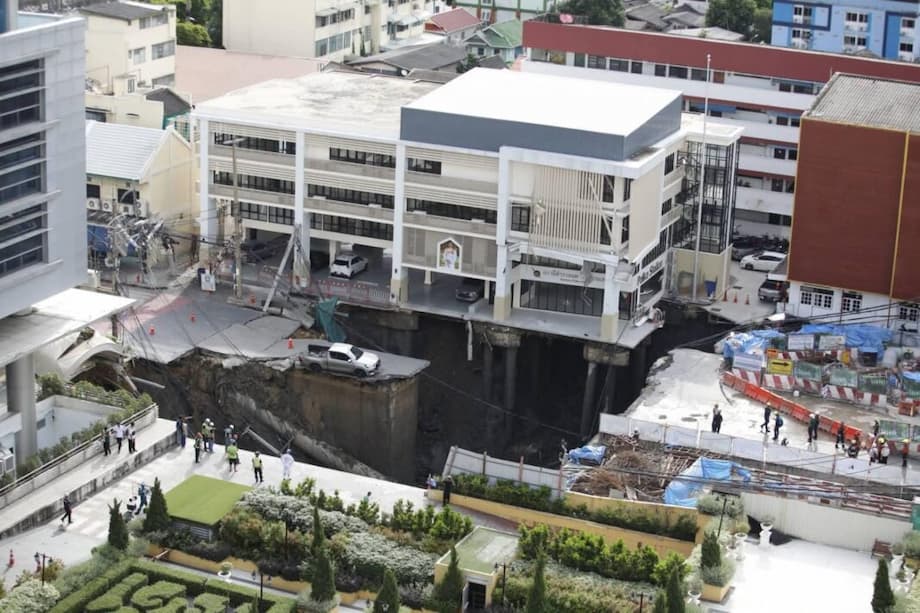What happened on Samsen Road
A large section of Samsen Road outside Vajira Hospital collapsed on Wednesday morning, carving a cavernous sinkhole in Bangkok’s Dusit district near the Chao Phraya River. The failure struck during the morning commute beside construction for the new MRT Purple Line’s Vajira Hospital Station. Soil rushed into the underground works, undermining the surface until the roadway gave way. The crater, roughly 30 by 30 meters and reportedly as deep as 50 meters, opened quickly. Two electricity poles and a pickup truck plunged into the void while crews pulled other vehicles back from the edge. No injuries were reported, a rare relief given the scale and timing.
The collapse triggered cascading utility failures. A major water main burst and poured into the hole, cutting tap water to neighborhoods along 31 roads. Power lines were dragged down and de-energized for safety. Police shut traffic from Vajira intersection to Sanghi intersection. The closure severed a key corridor and choked the Krung Thon Bridge with long queues. Across the street, the Samsen police station suffered damage at its foundation piles, and officers and nearby residents evacuated as a precaution.
Bangkok governor Chadchart Sittipunt said the road failed when soil found a path into the metro tunnel at the junction with the station after the station ceiling was damaged. The side toward the Sanghi Bridge was reported stable, but the collapsed side sat above softer ground with limited support. Vajira Hospital suspended outpatient services for two days, affecting about 3,500 patients. Emergency care and surgery continued. The Mass Rapid Transit Authority halted construction at the site and launched a technical review with city engineers and disaster teams.
How the morning unfolded
The sequence moved quickly in the first hour, triggering fast evacuations and a multi agency response.
- 7:13 am: The first slump appears on Samsen Road in front of Vajira Hospital and begins widening.
- 7:24 am: Authorities start evacuating patients, hospital staff and the public from the risk zone.
- 7:45 am: Two power poles and a tow truck tumble into the sinkhole as the void expands.
- 7:50 am: Residents in nearby apartment blocks are told to leave their buildings.
- 8:00 am: The governor arrives on site and coordinates with emergency agencies.
- Late morning: Tap water and electricity are cut in the immediate area for safety, and the police station relocates operations to a temporary base about 2.4 kilometers away.
- Afternoon: Engineers cordon a 100 meter radius as subsidence continues at the rim and cranes remove vehicles near the edge.
By midday, the sinkhole was fenced off, and teams focused on stopping inflows into the tunnel, assessing structures and stabilizing the perimeter.
What caused the collapse
The emerging picture centers on the interface between the under construction station box and the bored tunnels. Underground metro stations are excavated as large rectangular boxes enclosed by thick concrete diaphragm walls. The roof slab, often referred to on site as the station ceiling, closes the top. Running tunnels then connect to the box through reinforced openings sealed with membranes and grout. If that seal is damaged or incomplete, pressurized soil and groundwater can find a path into the void. Engineers call the process piping. Once it starts, the inward flow can erode support beneath streets and buildings.
The governor said soil entered the tunnel and station through damage at the junction, pulling the road into the opening above. A burst water main added volume and force, which can scour soil and widen a cavity. The city’s disaster prevention chief also pointed to recent heavy rain and a leaky pipe, consistent with how water accelerates erosion in soft ground. The site lies near the river on Bangkok clay, a soft, compressible layer with a high water table. That geology demands careful sequencing, support, and around the clock monitoring during underground works.
Investigators are now examining waterproofing at the station opening, the status of ground improvement around the box, and whether temporary supports were adequate. Instrument records such as settlement markers and piezometers should indicate if there were warning signs. Findings will determine whether design, construction methods, supervision, or an external utility failure triggered the event.
Hospitals, police and residents
Vajira Hospital closed outpatient services for two days while keeping inpatient care and the emergency department running. Administrators said roughly 3,500 outpatient appointments will be rescheduled as staff reach out to patients. City officials reported the hospital building remains safe because of deep foundation walls and careful design.
The five story Samsen police station across the road suffered broken foundation piles and cracks at the base. All officers left the building, and the station set up a temporary base several kilometers away to maintain service in the neighborhood. Residents in nearby flats were evacuated as a precaution. City engineers are inspecting structures around the site for settlement and damage.
The lack of injuries owes much to quick action by crews. A pickup used by a construction team to block traffic was abandoned just before the ground failed. That truck, a tow truck and two power poles fell into the hole after the area had been cleared.
Government and MRTA response
The Mass Rapid Transit Authority stopped construction at the Vajira Hospital Station and began a technical assessment with the contractor joint venture. Deputy Prime Minister and Transport Minister Phiphat Ratchakitprakarn asked Deputy Transport Minister Mallika Jirapanwanich and MRTA Governor Kajphajon Udomthamphakdi to oversee site actions. Agencies coordinated with the Metropolitan Waterworks Authority, the Metropolitan Electricity Authority, telecommunications firms and police to secure utilities and manage traffic.
Prime Minister Anutin Charnvirakul visited the scene, ordered an urgent investigation and asked engineering experts to support the assessment. He described the event as an engineering issue and said public safety had been secured, with no fatalities. The MRTA will assess damages and identify responsible parties under contract and insurance terms.
Immediate technical steps include sealing any leaks into the tunnel, grouting voids, and stabilizing the rim to prevent additional collapse. Building surveys and ground movement checks are in progress. Weather teams are preparing for rain, which can mobilize more soil.
Utilities and traffic disruptions
The burst main disrupted tap water along 31 roads that depend on the line serving Samsen Road. Water trucks and alternative feeds typically cover critical locations such as hospitals, but homes and businesses faced dry taps for parts of the day. The Waterworks Authority is isolating the damaged section and routing around it where possible.
Power cuts in the immediate area reduced the risk of electric shock or fire as lines were torn down. The Electricity Authority is relocating lines and restoring circuits once the ground is stabilized. Telecommunications firms are re routing cables to bring service back.
Traffic remains closed from Vajira intersection to Sanghi intersection until engineers confirm the subgrade is stable. The closure caused long queues on the Krung Thon Bridge and surrounding arteries. Traffic police created detours and asked drivers to avoid Samsen Road while the BMA evaluates a staged reopening when safe.
What it means for the Purple Line and project finances
The failed section sits on the Purple Line extension from Tao Poon to Rat Burana, a city shaping link that crosses under the Chao Phraya River and serves the Parliament district, Sam Sen and neighborhoods south toward Suksawat. The work package is being delivered by a joint venture led by CH. Karnchang with Sino Thai Engineering and Construction. CK holds 55 percent and STECON 45 percent of the joint venture, with the contract valued at about 19 billion baht for this portion.
Construction has been paused at the station and will resume only after independent engineers agree that conditions are safe and the failure mode is closed. Prime Minister Anutin said repairs to the collapsed tunnel and road will take about a year. That timeline is consistent with similar large ground loss events, which require investigation, ground treatment, controlled re excavation, structural repairs and a rebuild of the road and utilities.
Early financial assessments in Bangkok suggest that if direct and indirect loss reached around 1 billion baht, profit at CK could fall by roughly one fifth for 2025 and STECON by more than one quarter. A STECON source has said the project is insured, which would offset a portion of costs, but details depend on policy terms and the investigation. Actual costs will become clear only after damage mapping and agreement on a remediation plan.
Engineering context and sinkhole mechanics
Subway lines pass through soft layers of clay and sand below Bangkok. Stations are excavated as large boxes held by diaphragm walls and internal beams. The roof slab or ceiling closes the top while construction continues below. Running tunnels approach the station, and crews break out through the box wall to connect. That interface is one of the most delicate phases because it requires temporary seals and a change of support as the tunnel transitions into the box.
If the seal at the opening is damaged or does not fully contact surrounding ground, soil and water can find the gap and begin to flow. The process can start slowly then accelerate as moving soil reduces pressure around the void, drawing in more ground. The surface sags and finally collapses. When a water main breaks at the same time, scouring accelerates the loss and the cavity grows faster. Heavy rain raises groundwater levels and promotes piping. These effects were present on Samsen Road.
Modern tunnel projects manage these risks with a bundle of measures. Common tools include compensation grouting to fill openings, pre grouting around weak layers, watertight membranes at interfaces, and real time instruments such as settlement plates, inclinometers and piezometers. Contractors also run action limits so that alarms trigger work stoppage and corrective steps. Investigators will examine whether thresholds were set and whether any alarms were recorded.
Safety measures and what to watch next
Crews on site are expected to install sheet piles or micropiles at the rim to prevent further slumping, then pump grout into voids and backfill to re establish support. Once ground movement stops, engineers will test the tunnel and station box, repair damaged concrete and segments, and rebuild utilities. Only after those steps can the city reconstruct the road deck and reopen all lanes.
The MRTA will account for damages and identify responsible parties in line with contracts and insurance. The city plans daily briefings until the area is stabilized. Rain management will remain a concern through the monsoon. Residents in the cordon can expect structural inspections and a staged return to their buildings when engineers consider them safe.
What to Know
- Huge sinkhole opened on Samsen Road outside Vajira Hospital in Bangkok, with no injuries reported.
- Crater measured about 30 by 30 meters and up to 50 meters deep; two power poles and vehicles fell in.
- Cause points to soil entering the Purple Line tunnel and station through damage at the station ceiling junction.
- A burst water main and recent heavy rain likely accelerated erosion in the soft ground near the river.
- MRTA halted construction; Prime Minister Anutin ordered an urgent investigation with engineering support.
- Vajira Hospital closed outpatient services for two days, affecting about 3,500 appointments; emergency and inpatient care remain open.
- Samsen Police Station showed foundation damage; officers and nearby residents were evacuated; a temporary police base was set up.
- Tap water cut across 31 roads; power and telecom lines are being rerouted; traffic closed between Vajira and Sanghi intersections with major congestion on Krung Thon Bridge.
- Repairs to the tunnel and road are expected to take about a year, pending investigation and a remediation plan; the project has insurance coverage.




